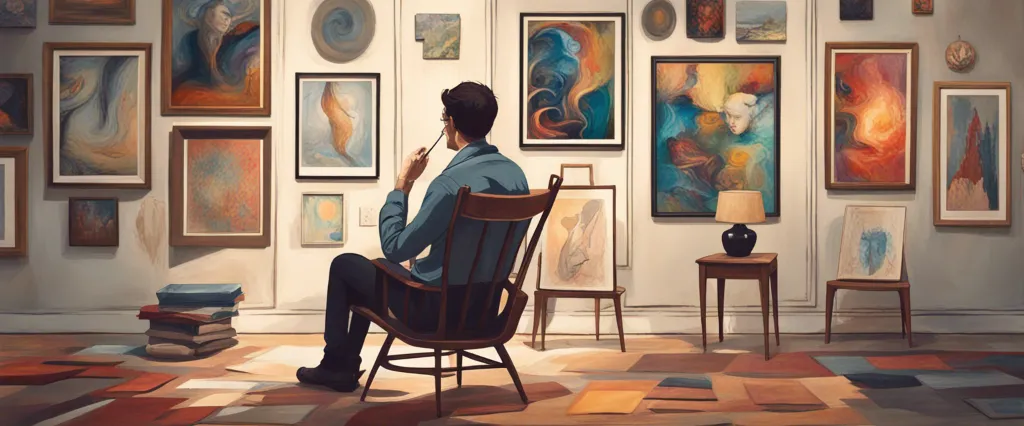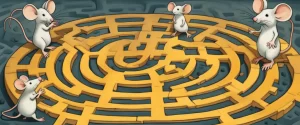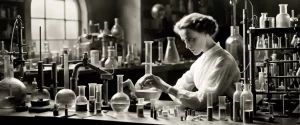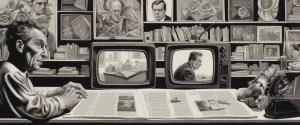
In our collective journey towards personal growth and self-discovery, we often find solace within the pages of books that offer insights, guidance, and novel perspectives. Two such books, Alain de Botton’s “Art as Therapy” and Bruce Fisher’s “Rebuilding,” delve into the complex realm of transformation and emotional healing. Acknowledging the importance of introspection and the power of art in facilitating personal development, both authors provide distinct approaches to navigating life’s challenges and finding inner resilience.
“Art as Therapy” by Alain de Botton serves as a guidebook for exploring the therapeutic potential of art in our daily lives. Drawing upon historical examples, psychological theories, and philosophical wisdom, de Botton unveils art’s ability to address our deepest emotional needs, ranging from love and hope to suffering and anxiety. By engaging with art, de Botton argues that we can gain valuable insights, foster self-reflection, and find comfort and solace amidst life’s trials. The book invites readers to explore the hidden messages embedded within artworks, encouraging an immersive and personal journey of emotional discovery.
On the other hand, Bruce Fisher’s “Rebuilding” offers a compassionate and practical roadmap for individuals reeling from the aftermath of a failed romantic relationship. Fisher presents an empathetic approach grounded in his own observations as a relationship counselor, laying out a step-by-step process to rebuild one’s life after experiencing heartbreak. With a focus on understanding the grieving process, addressing negative emotions, and fostering self-compassion, “Rebuilding” unveils a transformative path towards healing, growth, and ultimately, the rediscovery of love. Fisher’s pragmatic approach, combined with his rich experience in guiding others through relationship transitions, offers readers a roadmap to confront their pain head-on and emerge stronger on the other side.
While both “Art as Therapy” and “Rebuilding” aim to navigate the intricacies of personal transformation, they differ in their core approaches. De Botton embraces art’s inherent ability to awaken dormant emotions and prompt introspection, suggesting that art itself can serve as a healing force. In contrast, Fisher concentrates on the development of specific self-reflective and healing practices, focused on rebuilding and reclaiming emotional well-being in the aftermath of emotional upheaval.
In this comparative study, we aim to explore and analyze the strengths, limitations, and unique contributions of each book in fostering personal growth and emotional healing. By examining the distinct philosophies, theories, and practical tools employed by de Botton and Fisher, we seek to unearth the broader implications of their work, providing readers with a comprehensive understanding of the transformative possibilities each author offers.
Through this exploration, we hope to shed light on the potential of art and self-reflection, elucidating the intricate ways in which personal growth can be nurtured and emotional resilience rebuilt. Ultimately, this comparative study aims to empower readers with a deeper understanding of their own transformative journeys and inspire contemplation on the profound connections between art, self-discovery, and healing.
Brief Summary of Two Books
Art as Therapy by Alain de Botton
“Art as Therapy” by Alain de Botton and John Armstrong explores the therapeutic power of art in our everyday lives. The book argues that art has the capacity to address our emotional and psychological needs, providing us with guidance, solace, and self-understanding.
Rather than viewing art in purely aesthetic terms or as detached from our daily concerns, de Botton and Armstrong propose that art can serve as a tool for personal transformation. They identify seven core functions that art can fulfill: remembering, hope, sorrow, rebalancing, self-understanding, growth, and appreciation.
Through various examples from different periods and genres, the authors illustrate how art can help us navigate the complexities of our emotional lives. They argue that art can serve as a psychological resource, allowing us to confront and work through specific emotional challenges, such as grief, love, anxiety, or existential questions.
As a guiding framework, de Botton and Armstrong suggest that art can be utilized in different areas of our lives, such as in communities, education, the workplace, and healthcare. They advocate for a more thoughtful and deliberate integration of art into our society, rather than its relegation to museums and galleries alone.
“Art as Therapy” presents a compelling case for how art can become a form of therapeutic intervention and a means of enriching our existence. By engaging with art in a more personal and meaningful way, we can find solace, inspiration, and emotional growth, ultimately enhancing our own well-being and the quality of our relationships and society as a whole.
Rebuilding by Bruce Fisher
“Rebuilding” by Bruce Fisher is a self-help book that addresses the process of recovering from a failed relationship and rebuilding one’s life. Fisher, a renowned therapist specializing in divorce counseling, guides readers through the stages of healing and growth following a breakup or divorce.
The book starts by acknowledging the pain and confusion experienced during the aftermath of separation. Fisher introduces the concept of the “divorce process” and explains that it involves various emotional stages, such as shock, denial, anger, and sadness. He provides insight into the different ways people cope during this challenging time and offers practical advice on managing emotions and self-care.
Fisher emphasizes the importance of accepting reality and taking responsibility for one’s own part in the failed relationship. He encourages readers to let go of bitterness and resentment, as these negative emotions hinder personal growth and hinder successful rebuilding. Instead, he suggests focusing on personal development, setting goals, and rediscovering individual identity outside of the relationship.
Throughout the book, Fisher highlights common patterns and pitfalls that individuals may encounter during the recovery process. He provides strategies for effective communication, conflict resolution, and establishing healthy boundaries. Additionally, Fisher offers guidance on navigating new relationships and forming healthier attachments in the future.
“Rebuilding” presents a compassionate and practical approach to healing from a breakup or divorce. Fisher’s expertise, combined with real-life case studies, actionable advice, and exercises, provides readers with the tools they need to rebuild their lives and move forward in a positive and fulfilling way.
Comparison between Two Books

Similarities in Psychological Healing
Both “Art as Therapy” by Alain de Botton and “Rebuilding” by Bruce Fisher delve into the concept of psychological healing and offer unique perspectives on how individuals can restore their emotional well-being. Despite their different focuses, the books share several similarities in their approach to this topic.
1. Recognition of the healing power of art: Both authors acknowledge the therapeutic potential of art in promoting psychological healing. De Botton suggests that art can provide solace, provoke self-reflection, and facilitate emotional release. Fisher, on the other hand, emphasizes the use of expressive art therapy as a tool for rebuilding one’s life after a significant loss, such as a breakup or divorce. They both argue that engaging with art can offer individuals a means of processing emotions, expressing themselves, and finding solace during periods of distress.
2. Incorporation of creative activities: Both books advocate for the use of creative activities as a means of psychological healing. De Botton encourages individuals to actively engage with art, whether creating their own artworks or immersing themselves in the works of others, to find emotional catharsis and inspiration. Fisher highlights the role of creative expression, such as journaling, painting, or music, in helping individuals rebuild their sense of self and make sense of their experiences. By engaging in these creative activities, both authors believe individuals can tap into their inner resources and unlock their capacity for healing.
3. A focus on self-reflection and self-awareness: Another similarity lies in the emphasis on self-reflection and self-awareness as crucial components of the healing process. De Botton argues that art can serve as a mirror, allowing individuals to examine their innermost thoughts and emotions. By engaging with art, individuals gain insight into their own psyche, fostering self-awareness and enabling them to better understand and address their emotional wounds. Similarly, Fisher encourages readers to reflect on their thoughts, emotions, and behaviors while engaging in artistic activities. He suggests that self-reflection provides individuals with an opportunity to confront their pain, break free from destructive patterns, and ultimately rebuild their lives.
4. Integration of psychological concepts: Both authors incorporate various psychological concepts into their works to support their theories of psychological healing. De Botton draws on psychoanalytic theories and concepts, such as repression, projection, and catharsis, to shed light on how art can facilitate emotional healing and catharsis. He also explores the healing power of empathy and art’s ability to foster connection and understanding between individuals. Fisher integrates principles of grief and loss therapy, as well as cognitive-behavioral therapy, into his approach to rebuilding after a loss. By understanding and applying these psychological concepts, individuals can gain insights and tools to support their healing journey.
While “Art as Therapy” primarily focuses on the broader role of art in psychological healing, and “Rebuilding” specifically tackles the aftermath of a significant loss, both books share a similar intention to guide readers towards a path of psychological well-being. Through their emphasis on art, creative activities, self-reflection, and integration of psychological concepts, these books offer readers a holistic understanding of healing and provide practical tools to support the process.
Divergences in Psychological Healing
“Art as Therapy” by Alain de Botton and “Rebuilding” by Bruce Fisher are both influential works in the field of psychology, focusing on the concept of healing. While both books explore different aspects of psychological healing, they diverge in their approach and emphasis on the role of art and rebuilding.
In “Art as Therapy,” de Botton argues that art serves as a powerful tool for psychological healing. He suggests that art has the ability to address various emotional and psychological needs, such as finding consolation, expressing repressed desires, and promoting self-understanding. De Botton proposes that by engaging with art, individuals can tap into their own emotions and experiences, interpreting the artwork in a way that resonates with their own personal struggles. The book encourages readers to view art as a form of therapy, emphasizing the therapeutic potential of the art experience.
On the other hand, “Rebuilding” by Bruce Fisher focuses primarily on the process of rebuilding oneself after a major loss, particularly through the lens of rebuilding after a painful breakup or divorce. Fisher’s approach is more structured and practical, presenting a step-by-step program to help individuals navigate their emotions and regain stability. The book outlines the various stages of healing, including accepting loss, examining personal responsibility, understanding patterns, rediscovering a sense of self, and eventually establishing new relationships. “Rebuilding” focuses less on the role of art and more on the individual’s ability to rebuild their life through personal reflection and interpersonal connections.
The divergence in these books lies in their focus and methodology. “Art as Therapy” highlights the value of art as a therapeutic tool, suggesting that engaging with art can bring about healing and emotional growth. On the contrary, “Rebuilding” focuses on practical steps and strategies for psychological healing, with less emphasis on the expressive and interpretive nature of art.
Both books offer unique perspectives on psychological healing, with “Art as Therapy” emphasizing the power of art to evoke emotions and self-reflection, while “Rebuilding” presents a structured framework for rebuilding one’s life after loss. These differing approaches reflect the multifaceted nature of psychological healing and cater to different individuals’ needs and preferences.

Conclusion
Both Art as Therapy by Alain de Botton and Rebuilding by Bruce Fisher are highly regarded books that offer valuable insights and perspectives on personal growth and healing. Ultimately, the choice between the two will depend on your specific interests and needs.
Art as Therapy explores how art can be used as a powerful tool for self-reflection, emotional healing, and personal transformation. It delves into how art can help us navigate various aspects of our lives, such as love, nature, work, and politics. Alain de Botton and John Armstrong provide thought-provoking ideas and use different artworks as examples to illustrate their points, making the book a visually engaging read.
On the other hand, Rebuilding focuses on the process of recovering from a breakup or divorce. Written by renowned therapist Bruce Fisher, it offers practical guidance and supports individuals in rebuilding their lives after a significant loss. The book provides a step-by-step program for healing emotional wounds, understanding relationship dynamics, and moving forward with renewed strength and resilience.
If you are particularly interested in exploring the transformative power of art and its role in personal growth, Art as Therapy may be more relevant. On the other hand, if you have recently experienced a breakup or divorce and are looking for practical guidance in rebuilding your life, Rebuilding may be more suited to your current situation.
Ultimately, both books discuss important themes related to personal growth and healing, so it may also be worthwhile to consider reading both of them in the long run.


